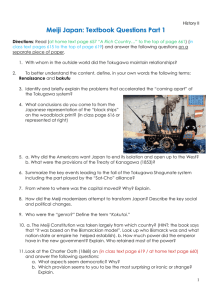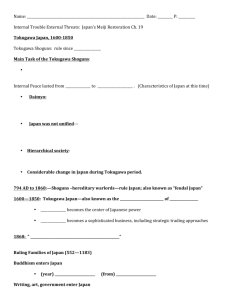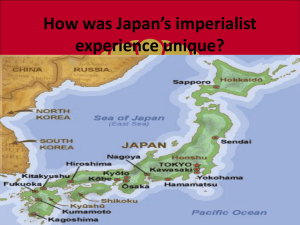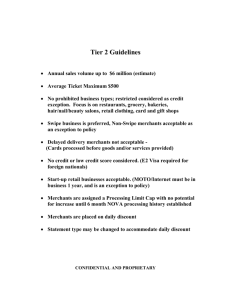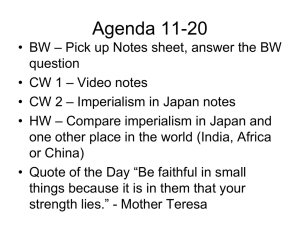File - South Central Asia
advertisement
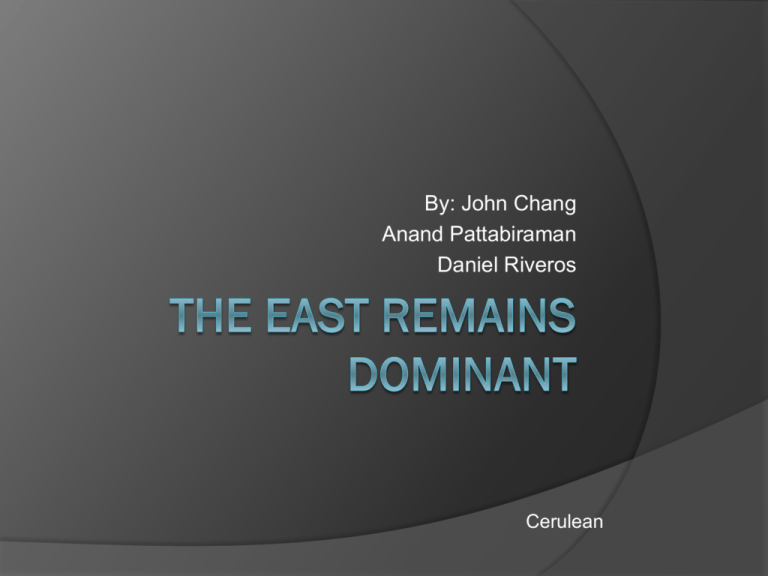
By: John Chang Anand Pattabiraman Daniel Riveros Cerulean The East over the West 12OO – 18OO East stayed ahead of West up until late 19th century Economically more advanced 1750 – East had 220% more income 1830 – East had 124% more income 1860 – East had35% more income 1870 – Europe finally caught up Strong Economic Proof 1820 – China compromised 29% of the world’s GDP, Can be attributed to overpopulation. 1750 – When compared to 1960 US dollars, China had equal per capita income to that of leaders in Europe. East’s GDP China compromised 33% of the world’s manufacturing Comparing China to Britain 1750 – China had 1600% output than that of Britain 1800 – 670% 1830 -215% 1860 – Britain’s output finally equal China’s In 1750 West contributed 23% while East had 77% Only after 1850 did the West surpass the East West surpasses the East West GNP overtakes East in 1870 Ottoman Turkish never fell behind the West before 19th century ○ Standards of living must also be taking into account Japanese generally ate healthier than British China was more advanced water wise than Europe Eurocentric argument Europe usually took bullion exports from other parts of the world Andre Gunder Frank describes how the Americas and Japan produced silver, and Africa exported gold. However, Europe hardly produced anything Europe was at a lost Asians supposedly preferred bullion because of hording 1. Asians collected taxes, which forced for more commercial economy 2. Asians resorted to global arbitrage (foreign exchange to profit from unequal prices) 3. Exchanged silver for gold, not hoarding but profiting 4. Used bullion to boost circulation and production India and Oriental Despotism Eurocentric historians believe that India was a classical case of Oriental Despotism due to several beliefs: Mughal anti capitalism Mughal state was “all grasping” No source of Indian credit Rich merchants inexistent Indian commerce was insignificant prior to British imperialism India was isolated from International Trade India could not obtain powerful productive power. The Mughal Empire crushed all capitalist activity. Mughal Empire was either passive or promoted capitalism demonstrated by: Royal navy aiding Gujurati merchants. Exchange of peace-keeping letters between Mughal rulers and neighboring empires. The Mughal State was “all grasping” Central state devolved power to the local authorities. Trades and prices not administered by Central State. Lack of monopolies in the economy. There could not be sources of Credit in the economy of India. Had well developed financial institutions. Ahmadabad merchants recorded all payments and debts on paper. Sarrafs engaged in deposit banking with merchants. Rich merchants could not exist in India. Several extremely rich merchants did exist: Abdul Ghafur – English East India Company Virji Vora – Dutch East India Company Indian trade was insignificant prior to British Imperialism. India was viewed as exotic and only cared for luxury trade – spices and textiles. Town merchants actually controlled many of the peddlers. Many long-distance traders who controlled Indian Ocean trade. India was isolated from International Trade. India was oriented towards an export economy rather than import. India focused on Indian Ocean and internal commerce. Railways carried 2,500 metric-ton miles. India could not have impressive levels of productive power. Wootz Steel Industry produced Damascus swords. Cotton and Textile Industry controlled by India until 18th century Tokugawa Japan (1603 – 1868) Often assumed as: Backward and stagnant Oriental despotism Feudal economy However, Japanese economic growth rate in Meiji Period exceeded almost all European economies. Per capita income growth during Tokugawa Meiji Period ended Feudalism? Merely an endpoint of policies to undermine strongholds of feudalism Daimyo (aristocracy) Samurai (military vassals) Policies began in first half of 1600s http://homepage.ntlworld.com/neil_james. bruce/Honda-copy.jpg Daimyo Forced to live in Edo Reduced local autonomy Accumulated high personal debt Land taken by Meiji state to get rid of debt http://en.wikipedia.org/wiki/Image:Loc ation_TokyoJapan.jpg Samurai Forced to live in castle towns Growing urban numbers led to advances in agriculture Markets took over subsistence cropping Samurai separation promoted incentive for peasants to produce more Eventually led to commercialization Rapid Commercialization Peasants’ knowledge enhanced through agricultural treatises More area for irrigated crops Rising productivity levels National currency http://www.pierremarteau.com/images/coins/japankoban-1714.jpg Tokugawa Japan http://www.ww norton.com/coll ege/history/wor lds/images/ma p4_6.jpg Economic Significance 1630 - First credit institutions formed in Osaka 1670 – Group of Ten responsible for money market Similar to a central bank Held final reserves of banking system Deposits, advances, bill discounts, insurance Advancement of industry Fishing, textiles, paper-making, metalworking Japanese Isolationism Sakoku – ‘closed country’ in 1639 Eurocentric scholars believe Japan withdrew from international trade Confirms oriental despotism and economic stagnancy Japanese Isolationism Eurocentric scholars misunderstood sakoku Policy used to regulate foreign trade and get rid of foreign Catholic ideas Japan continued trade with China, Korea, Dutch, Siam, and later, SouthEast Asia Eurocentric vs. Hobson • Commodore Perry opened up a closed Japan – Japan was already global • Meiji Japan only succeeded because it imitated the West – Industrialization prompted to counter China’s dominance • Tokugawa Japan was regressive oriental despotism – Groundwork for Meiji industrialization laid during Tokugawa Period
